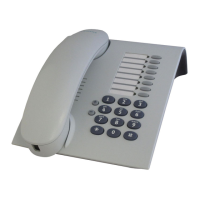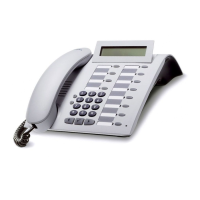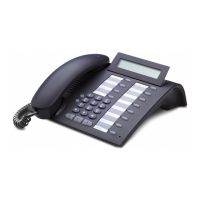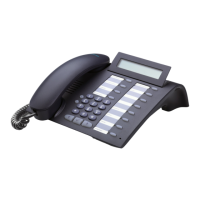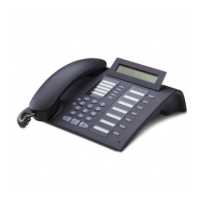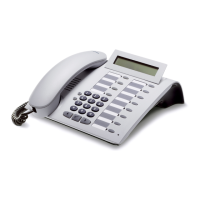
Do you have a question about the Siemens optiPoint 500 economy and is the answer not in the manual?
| Number of Programmable Keys | 8 |
|---|---|
| Speakerphone | Yes |
| Headset Connection | Yes |
| Color | Black |
| Wall Mountable | Yes |
| Lines | 2 |
| Type | Digital Telephone |
| Display | 2-line LCD |
| Power Supply | External power adapter |
| Headset Port | RJ-9 |
Compares features of optiPoint 500 economy, basic, standard, and advance models.
Explains guide symbols, structure, and how to interpret display information.
Covers activating functions directly, via Service Menu, or using function keys.
Details basic, enhanced, multiline, group, and executive/secretary functions.
Explains optional main menu and tips for optimal telephone use.
Instructions for answering calls using handset, speakerphone, or headset.
How to activate/deactivate call waiting and manage waiting calls.
Retrieving messages and handling callback requests from the mailbox.
Setting and receiving timed reminders for appointments or meetings.
Managing incoming calls on loudspeaker and controlling voice calling.
Enabling/disabling the Do Not Disturb feature to manage incoming calls.
Procedure for tracing malicious external callers by registering their number.
Steps for dialing calls with handset off-hook or on-hook.
Hiding caller ID and making direct voice calls to internal users.
Using DTMF tones to control external equipment or systems after dialing.
Making second calls for consultation and switching between active calls.
Instructions for creating, expanding, and managing conference calls.
Covers chairing, disconnecting, and handing over conference leadership.
Overview of station-controlled conferences and supported functions.
Procedures for transferring calls and entire conferences to other parties.
Explains functions of the switchover button for various call scenarios.
Displaying caller information briefly during waiting calls or consultations.
Methods for automatically or manually parking calls and retrieving them later.
Explains parking restrictions and procedures for telephones without displays.
Understanding parking limitations and the behavior of automatic/manual parking.
Viewing and managing the call log of incoming and outgoing calls.
Using last number redial, repertory keys, and individual/system speed dialing.
Assigning external calls to specific projects using codes and PINs.
Requesting a callback when a called party is busy or unavailable.
Accessing busy lines via camp-on or overriding calls for urgent contact.
Customizing ringer volume/pitch and adapting speakerphone acoustics.
Adjusting display contrast, backlight, and angle for optimal viewing.
Securing the phone with PIN/chip card and choosing the display language.
Programming numbers onto programmable keys for quick dialing and redialing.
Assigning numbers to specific digit keys for individual speed dialing.
Setting and managing timed reminders for appointments.
Verifying telephone operation by testing keys, display, and audio functions.
Verifying functions assigned to specific keys.
Instructions for fixed and variable call forwarding on Hicom and HiPath systems.
Programming, activating, deactivating, and cancelling call forwarding destinations.
Setting up call forwarding for other terminals like fax machines or PCs.
Using service codes and dedicated keys to manage call forwarding.
Procedures for accessing other telephones using PIN or chip card authentication.
Steps to log off from another telephone after use.
Steps for logging off a telephone from its current line and logging it on at a new location.
Making voice calls to internal users via loudspeakers.
Initiating voice calls to groups and making announcements to line groups.
Conducting two-way voice calls within groups, activating microphones and loudspeakers.
Explains line key configuration, lamp states, and basic usage.
Taking calls in order or with priority, and managing multiple lines.
Managing calls on hold, exclusive hold, and transferring calls between lines.
Handling calls within pickup groups and hunt groups.
Using DSS keys to call and take calls for other users.
Procedures for making calls and handling incoming calls between executive and secretary.
Extending, forwarding, and taking calls for the executive.
Managing calls with a second telephone and activating call waiting for the executive.
Diverting executive calls to a deputy when the secretary is unavailable.
Instructions for labeling keys and accessing user manuals.
Lists and describes various optiPoint accessories for customization.
Connecting a PC via USB for telephone applications.
Guidelines for cleaning the telephone safely and effectively.
Resolving problems like unresponsive keys, no ringing tone, or inability to dial.
Interpreting common error messages and their possible responses.
Guidance on who to contact for unresolved telephone issues.
Quick reference for making calls, redialing, switching handset/speakerphone, and extending calls.
Summaries of conferences, call forwarding, speed dialing, and other key features.
Service menu options for call forwarding, speed dialing, and call controls.
Service menu functions for PIN management, terminal tests, and additional features.
Service menu options for call forwarding, speed dialing, and call controls on Hicom.
Service menu functions for Hicom PIN management, terminal tests, and additional features.
